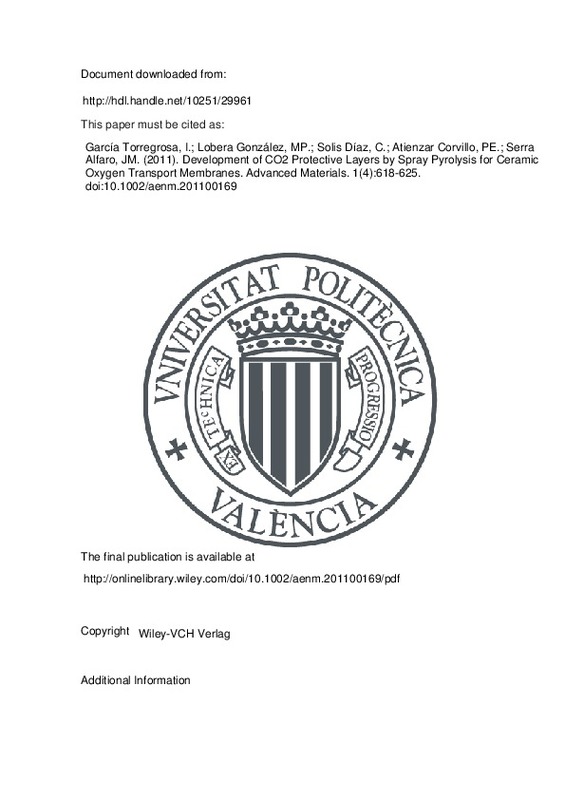JavaScript is disabled for your browser. Some features of this site may not work without it.
Buscar en RiuNet
Listar
Mi cuenta
Estadísticas
Ayuda RiuNet
Admin. UPV
Development of CO2 Protective Layers by Spray Pyrolysis for Ceramic Oxygen Transport Membranes
Mostrar el registro sencillo del ítem
Ficheros en el ítem
| dc.contributor.author | García Torregrosa, Iván
|
es_ES |
| dc.contributor.author | Lobera González, Maria Pilar
|
es_ES |
| dc.contributor.author | Solis Díaz, Cecilia
|
es_ES |
| dc.contributor.author | Atienzar Corvillo, Pedro Enrique
|
es_ES |
| dc.contributor.author | Serra Alfaro, José Manuel
|
es_ES |
| dc.date.accessioned | 2013-06-21T12:24:21Z | |
| dc.date.issued | 2011 | |
| dc.identifier.issn | 0935-9648 | |
| dc.identifier.uri | http://hdl.handle.net/10251/29961 | |
| dc.description.abstract | [EN] Ceramic mixed ionic¿electronic conducting (MIEC) membranes enable very selective oxygen separation from air at high temperatures. Two major potential applications of oxygen-transport membranes are: i) oxygen production for oxyfuel power plants, and, ii) integration within high-temperature catalytic membrane reactors for methane or alkane upgrading by selective oxidative conversions. However, these applications involve contact with carbon-bearing atmospheres and most state-of-the-art highly permeable MIEC membranes do not tolerate operation under CO 2 -rich environments due to carbonation processes. The present contribution shows our ¿ rst attempts in the development of ceria-based protective thin layers on monolithic LSCF membranes. Gd-doped ceria (CGO) deposition is carried out by air blast spray pyrolysis on mirror-polished LSCF disc membranes. The layer thickness is maintained below 0.4 ¿ m in order to prevent the formation of cracks during thermal cycling and minimize limitations caused by the reduced oxygen permeability through the ceria layer. After optimization of the spraying process, smooth crack-free dense coatings are obtained with high crystallinity in the as-deposited state. The layers are characterized by XRD, SEM, AFM, DC-conductivity measurements, interferometry and optical microscopy. Oxygen separation is studied on coated LSCF using air as the feed and argon/CO 2 mixtures as the sweep gas in the temperature range 650¿1000 ° C. The protected membrane exhibits a higher stability than the uncoated LSCF membrane, although the nominal oxygen ¿ ux is slightly reduced at temperatures below 850 ° C due to the limited ambipolar conductivity of doped ceria in the range of oxygen partial pressures investigated. Moreover, the protective layer (250 nm thickness) remains stable after the permeation testing. | es_ES |
| dc.description.sponsorship | Financial support by the Spanish Ministry for Science and Innovation (Project ENE2008-06302 and FPI Grant JAE-Pre 08-0058), the EU through FP7 NASA-OTM Project (NMP3-SL-2009-228701), and the Helmholtz Association of German Research Centers through the Helmholtz Alliance MEM-BRAIN (Initiative and Networking Fund) is kindly acknowledged. | en_EN |
| dc.language | Inglés | es_ES |
| dc.publisher | Wiley-VCH Verlag | es_ES |
| dc.relation.ispartof | Advanced Materials | es_ES |
| dc.rights | Reserva de todos los derechos | es_ES |
| dc.subject | OXIDE FUEL-CELLS | es_ES |
| dc.subject | CERIA THIN-FILMS | es_ES |
| dc.subject | ELECTRICAL-CONDUCTIVITY | es_ES |
| dc.subject | CEO2 | es_ES |
| dc.subject | DEPOSITION | es_ES |
| dc.subject | MICROSTRUCTURE | es_ES |
| dc.subject | ELECTROLYTES | es_ES |
| dc.subject | PERFORMANCE | es_ES |
| dc.subject | CONDUCTORS | es_ES |
| dc.subject | SEPARATION | es_ES |
| dc.subject.classification | QUIMICA ANALITICA | es_ES |
| dc.title | Development of CO2 Protective Layers by Spray Pyrolysis for Ceramic Oxygen Transport Membranes | es_ES |
| dc.type | Artículo | es_ES |
| dc.embargo.lift | 10000-01-01 | |
| dc.identifier.doi | 10.1002/aenm.201100169 | |
| dc.relation.projectID | info:eu-repo/grantAgreement/MICINN//ENE2008-06302/ES/BUSQUEDA DE NUEVOS MATERIALES CONDUCTORES DE OXIGENO E HIDROGENO EN ESTADO SOLIDO MEDIANTE QUIMICA COMBINATORIA/ | es_ES |
| dc.relation.projectID | info:eu-repo/grantAgreement/EC/FP7/228701/EU/NAnostructured Surface Activated ultra-thin Oxygen Transport Membrane/ | en_EN |
| dc.relation.projectID | info:eu-repo/grantAgreement/CSIC//JAE-Pre 08-0058/ | es_ES |
| dc.rights.accessRights | Abierto | es_ES |
| dc.contributor.affiliation | Universitat Politècnica de València. Instituto Universitario Mixto de Tecnología Química - Institut Universitari Mixt de Tecnologia Química | es_ES |
| dc.description.bibliographicCitation | García Torregrosa, I.; Lobera González, MP.; Solis Díaz, C.; Atienzar Corvillo, PE.; Serra Alfaro, JM. (2011). Development of CO2 Protective Layers by Spray Pyrolysis for Ceramic Oxygen Transport Membranes. Advanced Materials. 1(4):618-625. https://doi.org/10.1002/aenm.201100169 | es_ES |
| dc.description.accrualMethod | S | es_ES |
| dc.relation.publisherversion | http://onlinelibrary.wiley.com/doi/10.1002/aenm.201100169/pdf | es_ES |
| dc.description.upvformatpinicio | 618 | es_ES |
| dc.description.upvformatpfin | 625 | es_ES |
| dc.type.version | info:eu-repo/semantics/publishedVersion | es_ES |
| dc.description.volume | 1 | es_ES |
| dc.description.issue | 4 | es_ES |
| dc.relation.senia | 193468 | |
| dc.contributor.funder | Ministerio de Ciencia e Innovación | |
| dc.contributor.funder | Consejo Superior de Investigaciones Científicas | es_ES |
| dc.contributor.funder | European Commission | |
| dc.contributor.funder | Helmholtz Association of German Research Centers |







![[Cerrado]](/themes/UPV/images/candado.png)

